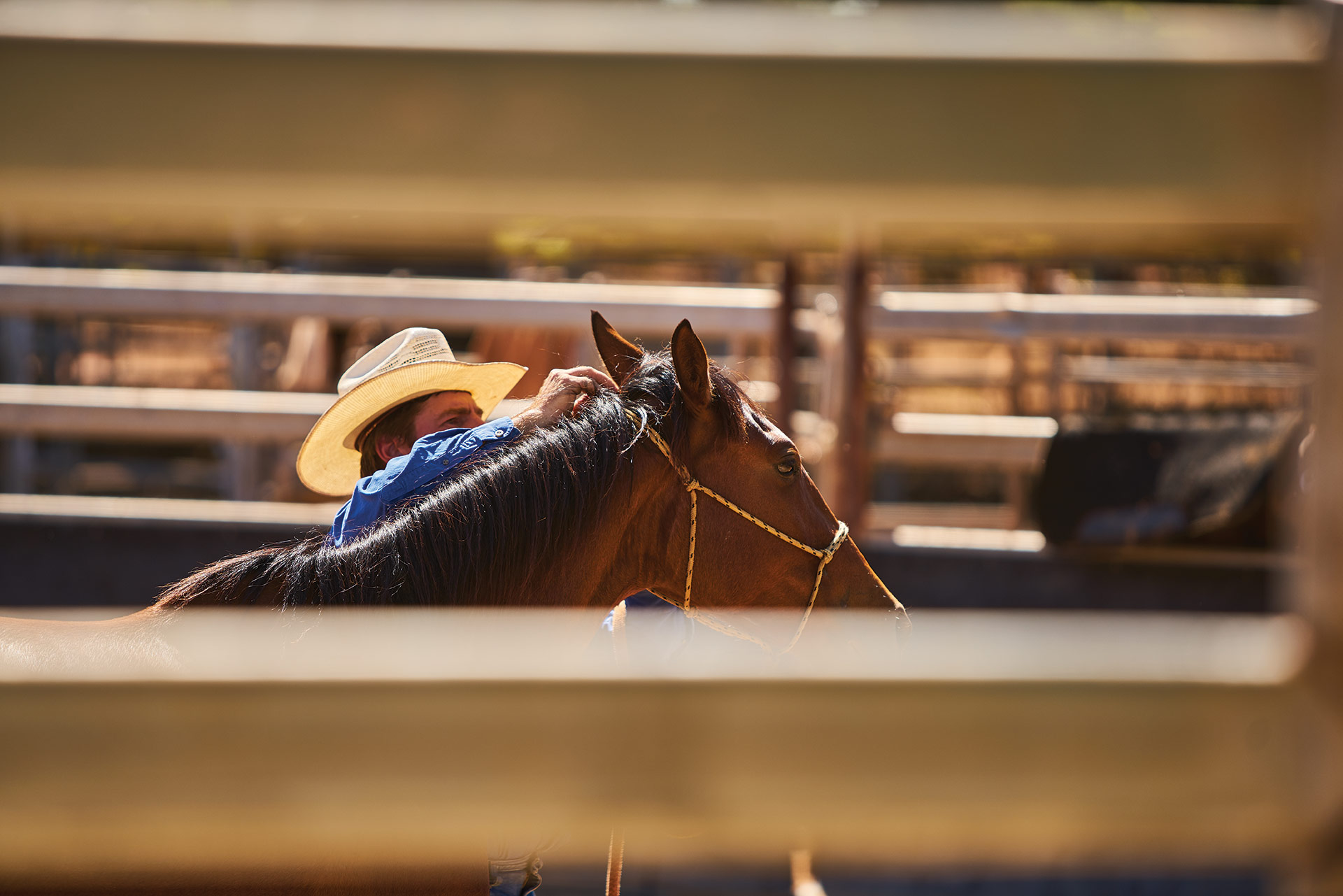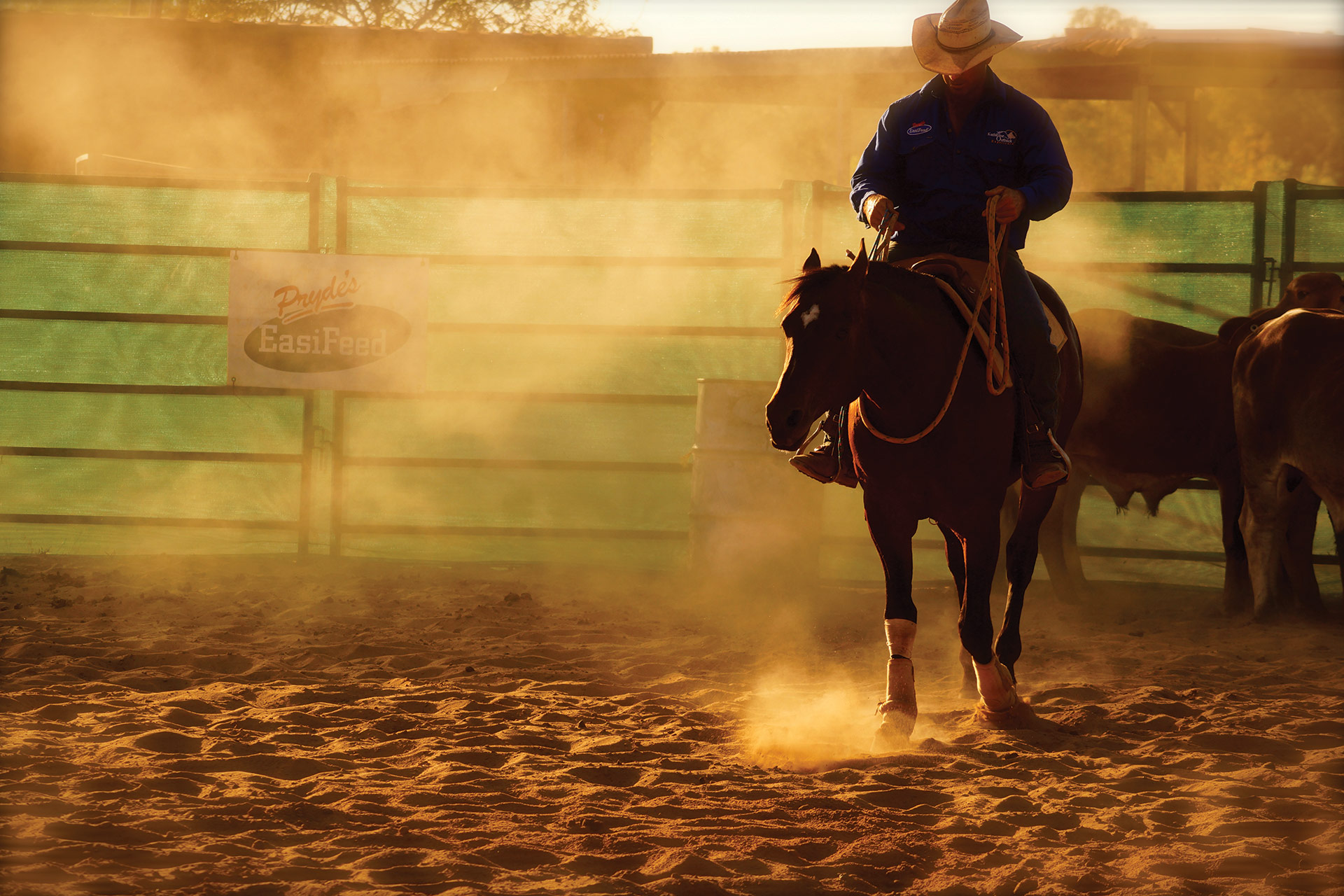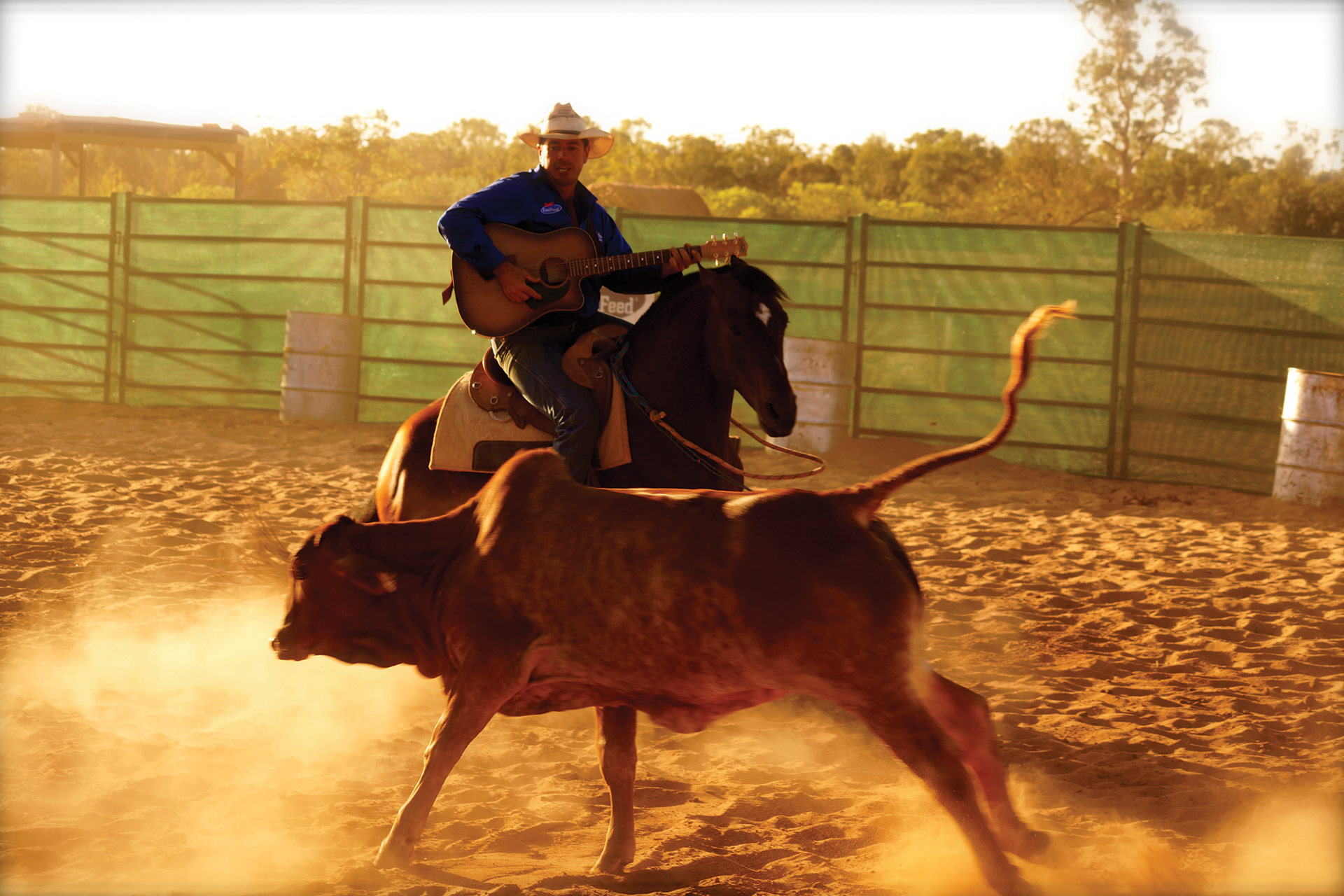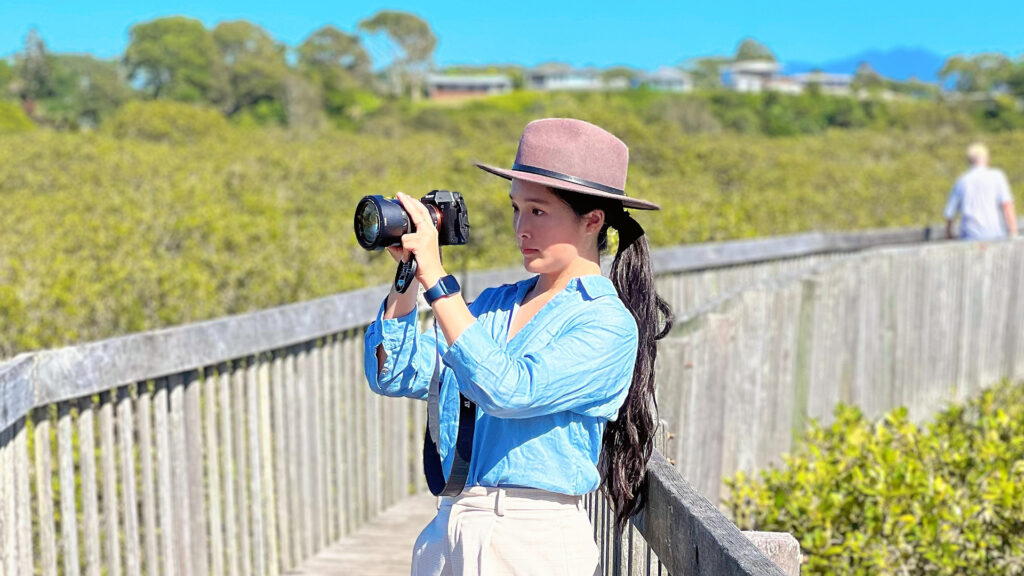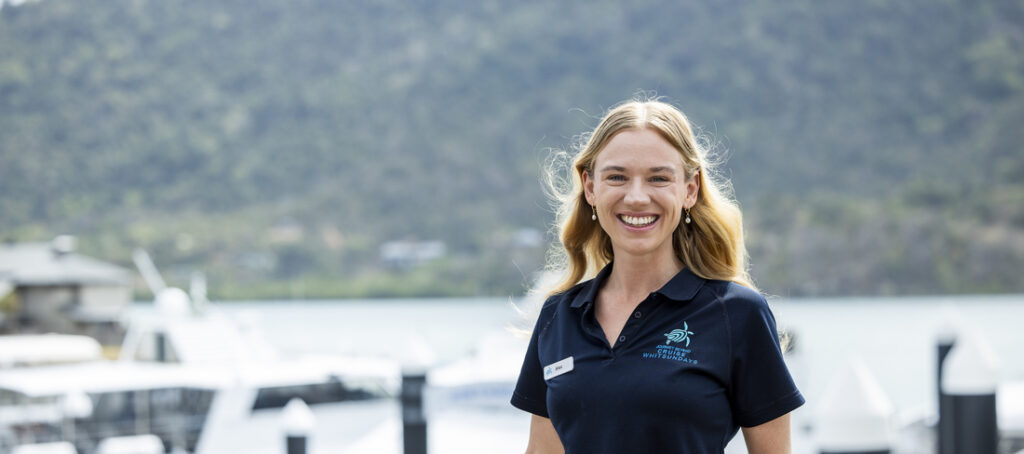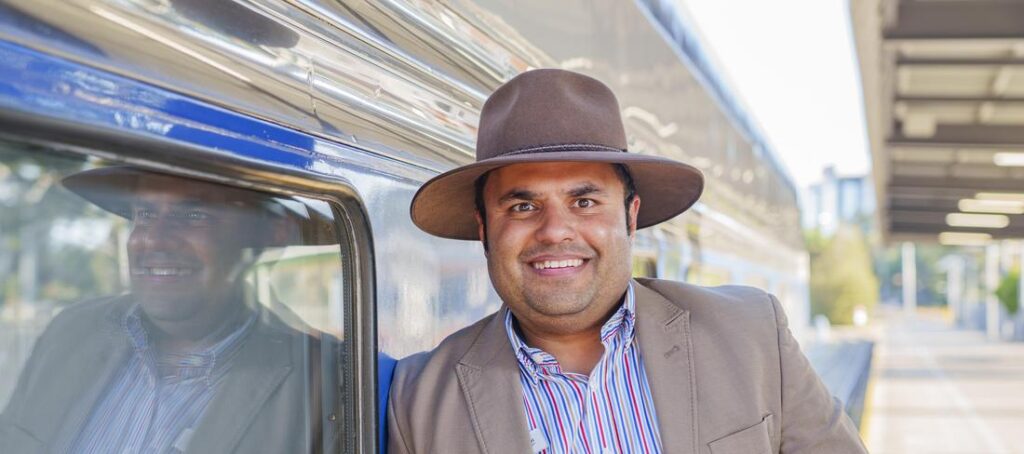WORDS Steve Madgwick
A mauve and baby blue unicorn with a silver horn and gossamer fairy wings squints at me, as if to say, “Get up, Princess, those horses won’t break in themselves.”
I assumed the invitation to sleep in the spare kid’s room was pure outback hospitality, but now, well, I’m starting to think it’s just phase one: mind games. After all, ‘normal’ farmhands don’t usually bed down in the homestead. Then again, I’m not normal.
I’ve landed at Tom Curtain’s property just outside Katherine, home base for his daily Outback Experience show, on a hands-on mission to see if Northern Territory hard yakka is indeed the most physically and spiritually taxing thing in the known universe.
Officially, Tom’s task is to work me like a dog on the farm, which although car-park sized by NT standards (20 acres) is ultra-intensive, thanks to his high-maintenance menagerie. Unofficially, I suspect, he intends to destroy this macchiato-sipping city boy in the name of bush pride.
I roll out of my single bed, boot up, notice it’s 6.30am. Fail number one: the horse-breakers have been a-breaking for almost two hours. In my defence, shrieking curlews – birds whose call sounds like an infant’s being kidnapped by a witch – fractured my beauty sleep last night.
I stride into the cool, barely broken morning where a farmhand grips a poddy calf firmly between her legs; the thirsty lil’ blighter struggles, sucks the bottle so hard that he could siphon concrete from Adelaide. No thanks.
In the next pen, the donkey or maybe one of the goats uncorks a dry-heave-triggering agrarian air-bender that makes me glad I haven’t had brekky yet. The other farmhand’s nostrils and gag reflex remain oblivious. Tom, who was reared on a 7000-acre peanut and cattle farm in Joh Bjelke-Petersen territory, beckons me into a military-grade enclosure for horse-breaking 101. Along with the hyperactive steed in question, he’s simultaneously training young Cody to do the bucking-hard breaking work. Cody hangs on Tom’s commands; cajoles and wrestles the brawny Australian stock horse, who circles around me like a pepper-sprayed land shark.
Tom unbuttons his laid-back country-lad persona at the gate when he faces wild horses; his language wanders into the locker-room. Horse whispering this certainly ain’t.
“Harder, like he’s an old horse,” Tom barks to Cody, then turns to me. “See how arrogant it is?” Yeah-nah…Just looks scared witless to me.
“I pretend to be the horse, get close to it, watch what its body language is saying; how it’s holding its tail. If it’s
angry, its nostrils will wrinkle. If it’s worried, the ears stand up.”
Tom learned these lessons bums on at vast Mt Sanford Station south of here, his first foray into the Territory, an experience which informed and inspired his debut album Smack Bang.
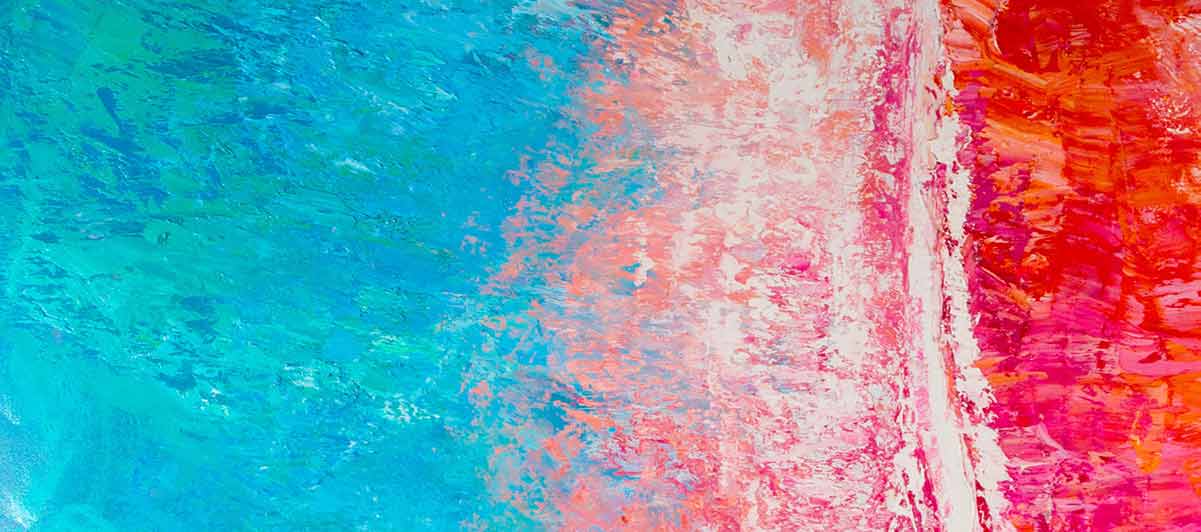
Apparently, 12 hours a day in the saddle, behind a big mob of cattle, gives you a lot of time to think and write songs, too.
“I’ve had horses chase me, knock me over. I’ve been kicked, grabbed by the neck, been bucked off, been on bolting horses. Even broken my wrist. Every time, I backtracked and asked myself, ‘Why did that happen?’, analysed the heck out of it.”
Ten minutes later, Tom swears he sees the precise moment the horse “relaxes”, and Cody gets the nod to mount it for the first time. The horse pirouettes cyclonically. I fight the impulse to Fosbury Flop over the fence to sanctuary but, before I can flee, it projectiles poop onto my boots. Phase (number) two in the grand plan, perhaps?
There seems to be about a week’s worth of feeding, watering and mending to squeeze in before this afternoon’s performance, itself a peculiar hybrid beast; part agricultural show, part rodeo, part concert, lubricated with a pannikin of nanny-state-shunning joie de vivre.
Tom’s next show stunt germinated from something a bloke in the audience once yelled out: “Why don’t you actually ride the buffalo?” So, naturally, he’s busy refining the technique, which includes wearing cricket pads, presumably to stop the gargantuan horns severing a femoral artery. Over our second cuppa and slice of fruitcake for the morning, I reiterate, with my serious face on, that buffalo riding is, and forever will be, above my pay grade. Fortuitously, it’s time to mend that pesky front gate.
Tom considers MIG welding a fundamental human skill, akin with tying shoelaces or using cutlery. “Never done it before?” he quizzes. “Really? Never?” Post fast-tracked lesson, I don the welding mask, which is a cranial sauna in the mid-morning swelter. I wince like a rescue dog when the sparks fly, a few of which singe into my upper arm; war wounds to show off to my big-city brethren, in lieu of a sleeve, I guess.
Tom praises my efforts; well, sort of. Apparently, my join marks are what welders call “chicken shit” (because they look like it) and he admits later that when he said, “That’ll do” what he actually meant was, “You’re about to burn a hole right through the fence.”
Next, well away from the heavy machinery, I roll one of those big round hay bales (300 kilograms) from the paddock to feed the unbroken horses, which I manage to spook into a kicking, bucking frenzy. Until now, I thought they were just cutesy decorations, but 300 grunting metres later, I sweat like a retired pack mule. Normally, they need to roll 12 of these out before smoko.
What-ever!
Tom schools me in the sharp art of whip-cracking, making it look bloody effortless, as if he started practicing with his own umbilical cord in the womb. I try to execute “big loops, strong change of direction” and, miraculously, first go, the whip utters a stifled “fffttt”. Okay, stand back. On my fourth attempt, it raises its voice to a ‘crackette’, but the tip recoils, strikes my chin like a vexed brown snake. I hand it back, remembering my mum’s mantra: “You’ll have an eye out with that thing.”
Even though my animal-training skills are exclusively goldfish related, Tom unleashes 10 of his show/working border collies on me. They pay me no heed, anarchically sprint past to a nearby paddock, like they’ve had a morning on the Red Bull and vodkas.
“Awayyyyy, baaaack, that’ll doooo…” sings Tom. The seasoned pooches react crisply, the apprentices noticeably needier. Collectively, cultishly, they circle around him like a canine twister.
Trev and I seem to connect. “Awwwwaeeeey,” I holler. Blank look. I try to ape Tom’s tone; then a few octaves higher, then lower. Tom remains deafeningly silent. “Not today, rookie,” woofs Trev. I try Elsie next, tethered onto the training pole, with a tasselled broom as my enchanted wand.
Apparently, a fine working dog like her is worth three good blokes out on a station, sans backchat. Using that metric, Elsie is worth exactly 103 of me. “They say dogs detect emotion in your voice,” says Tom. “That’s why a lot of trainers use whistles, but I just can’t [whistle].” Finally, something he can’t do. A turning point, perhaps.
As a Scooby Snack for my efforts, more like a fluffy attendance ribbon rather than a tangible trophy, I get to play with six eight-week-old border collie pups, who stumble, bumble and maul me with unblemished affection. Tom scoops up a couple of the muddy pups, his face softens noticeably, then something clicks.
I recall something he told me in my AM haze: “Some people’s mental framework is exactly like a dog’s. If you yell, some people can take it, but others take it to heart, start sulking, lose confidence.” Funny, he hasn’t yelled at me once.
I was wrong about him, about this place, drunk on my own urban pre-conceptions. I assumed that a horse breaker would have the emotional intelligence of a Mafia hitman, and that an outback farm would be so foreign to me that I’d need a special visa and
inoculations.
It turns out that Tom was never my nemesis, nor was he trying to work me like a dog – he was actually trying to train me like one.
City boy goes to the country, turns into a dog. Perhaps I could be the next sideshow in the Outback Spectacular. And, maybe, he’ll write a song about me one day too…
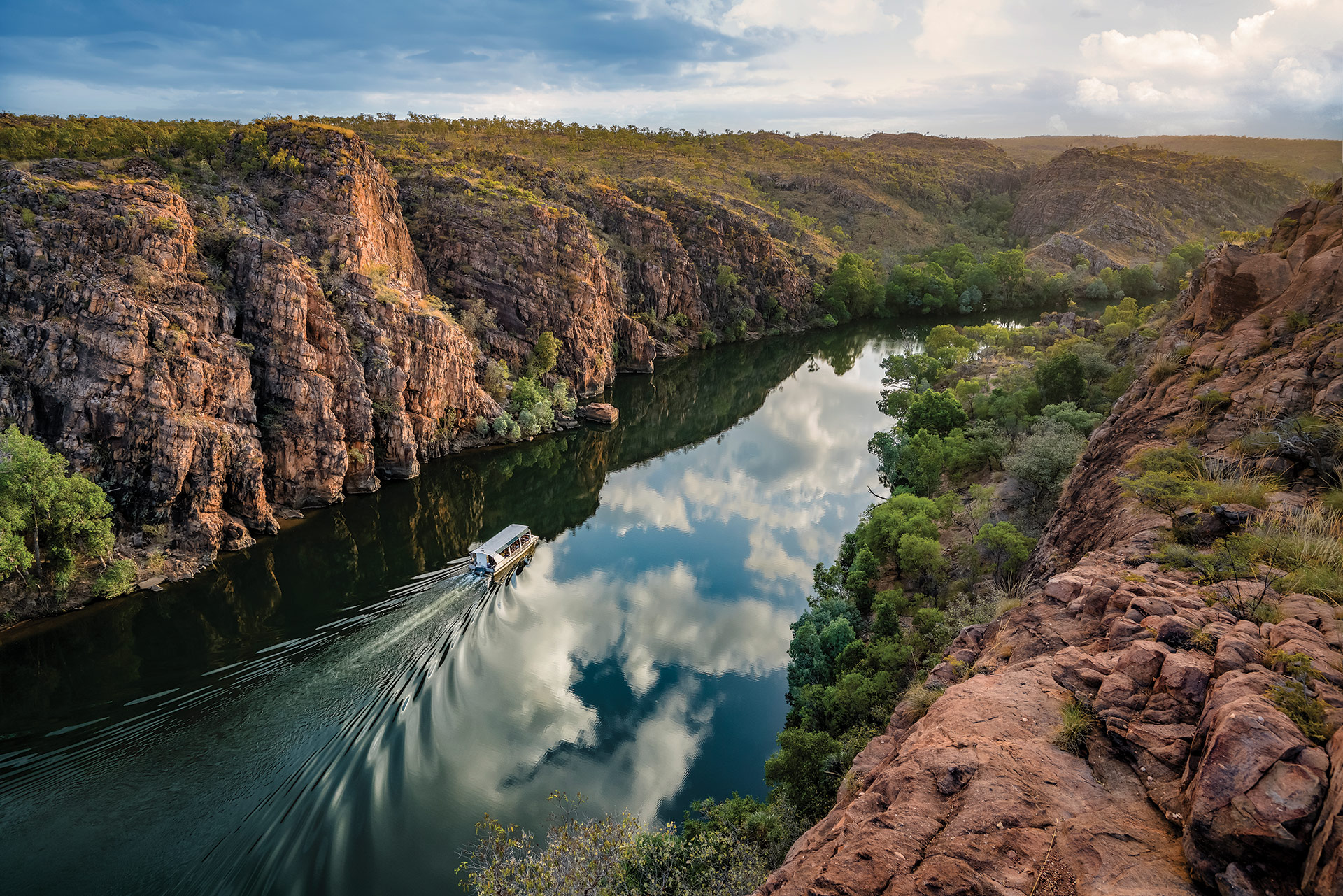
The pay-off: Nitmiluk Gorge
Boots off, thongs on, bucking horses long gone, left behind, forty-odd kilometres down the road at Katherine Outback Experience.
A solitary freshwater croc lies on the Katherine River’s beachy bank, legs splayed in idleness, like she’s digesting the NT equivalent of a full-English. A snaked-neck darter dries its wings like a rock god in mid-encore.
The best part is I don’t have to train them, clean them or fear them, now that my cowboy responsibilities are kaput. I just watch them. I like to watch. Yes, I have found the natural antidote to a brutal day’s farmyard toil: a languid cruise through Nitmiluk Gorge. These pair also happen to be my Katherine bucket list, along with seeing the ‘Jesus Loves Nachos’ graffiti on a bridge outside town.
The eons-old rust-red cliffs, gateway to the spectacular Arnhem Land plateau, are hypnotic in their immensity, a physical embodiment of the Jawoyn people’s narrative.
The afternoon’s cruise only laps at the area’s possibilities, covering two of the thirteen gorges, but it’s a rich taste,
a touchstone for ancient and modern culture: thousands-of-years-old rock art on the cliffs further immortalised in one
of indigenous Australia’s seminal films Jedda.
The site of the pandanus leaning over the river for a drink and the splash of a barramundi triggers a flash forward; a
thought-bubble to what’s on the menu tonight aboard The Ghan.
I see a bank of kayaks that I could use to explore deeper into the other 11 gorges. I usually would, but this dose of slow-cruise therapy is all I have planned for the rest of the day.

